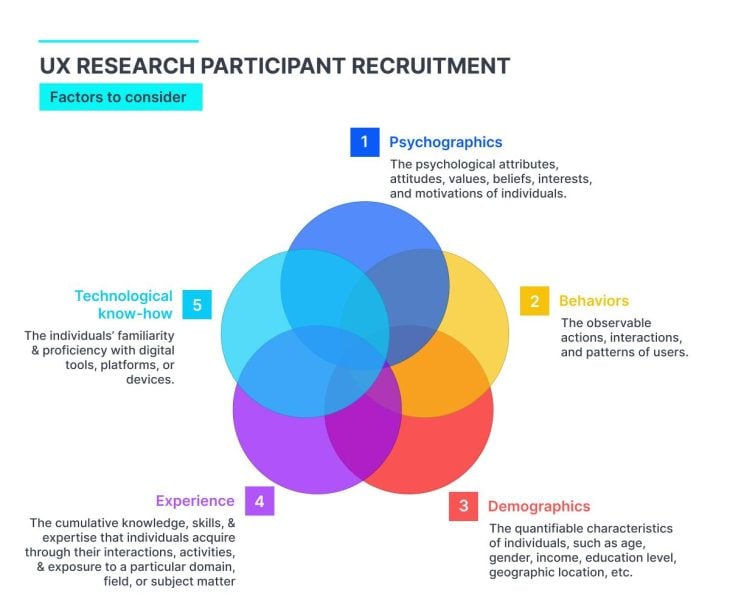Choosing the right UX research participants can make the difference between research that produces valuable insights and research that leads nowhere. That is to say, finding the right participants is crucial to the success of your user research. But this task can seem daunting if there are no clear-cut criteria for who qualifies as the “right” participant.

This article will help you identify the right participants for your research and show you how to recruit them, so you can get insights that impact the end users’ experience.
Ready? Let’s dive right in!
Before you can embark on any user research, you need to identify the people who are most likely to benefit from your product. For example, if your research is for a product for fitness enthusiasts, your target audience could be: “Adults who are interested in fitness and wellness.”
Another critical component you need before recruiting any research participant is a clear research objective.
A well-articulated research objective is akin to having a compass when embarking on a journey. It ensures that you get to your destination (answer). After all, if you don’t know the problem you’re trying to solve, how would you identify participants who can provide the answers you need?
You can define your research goal by identifying the questions you want to answer and the problems you want to solve.
For example:
Say you’re working on a product that helps fitness enthusiasts find the right workout gear, and your question is: “What challenges do fitness enthusiasts face when sourcing workout gear?” You can write your research objective as: “We will identify the most common challenges that fitness enthusiasts face when sourcing workout gear.”
Notice how the research objective is clear and actionable. By articulating your research objective in this way, you can already get an idea of the groups of people you need to recruit for your user research.
Next, you need to decide on your recruitment criteria.
It’s usually not feasible to involve all your target users when conducting research. So, what’s the next best thing? You select a representative sample of users that possess all the characteristics of your target audience.
You need to set clearly defined criteria for selecting your participants because your sample must be an accurate representation of your target. If the user research participants you select don’t match your target audience, your research will be useless, no matter how good your questions are.
For example:
Let’s revert to our earlier example involving a product for fitness enthusiasts. (Note that such a product would need more specific criteria than, say, a product for people who are just physically active.)
A good user research participant, in this case, would be someone who:
In general, your criteria should be defined by a mix of the following factors: psychographics, experience, demographics, behaviors, and technological know-how.

It’s also important to note that the level of difficulty you’ll encounter when choosing your participants depends on the specificity of your criteria. The less specific your criteria, the larger the number of potential participants to pool from.
The key here is to find the right balance.
If your requirements are too few, your participants won’t accurately represent your target audience. On the other hand, if there are too many, it can be difficult for you to find participants. A good practice is to evaluate the relevance of each of your criteria. Only include a criterion if it’s necessary.
Once you’ve set your recruitment criteria, you can create a screener — a survey that helps you determine if a potential participant matches the criteria you’ve set.
Think of a screener like a strainer in your kitchen sink; it catches any debris that might cause an obstruction if it finds its way down the drain. Similarly, the screener weeds out people that would waste your time and resources if they are allowed to participate in the research process.
To craft effective screening questions, you and your team can start by answering the following questions, adapted from Just Enough Research:
Once you’ve answered these questions, it’s time to start writing the actual screening questions. Here are some useful tips to keep in mind while at it:
For example:
Say you’re screening potential participants for a study on online shopping experience. A good screening question will be:
Which of these options best describes your online shopping habits? Please select one option.
Finally, keep your screener as short as possible. You don’t want potential participants dropping off before getting to the end.
Once your screening questions are sorted, it’s time for the main task: recruiting participants.
If you have the financial bandwidth, you can turn to online recruitment platforms as an efficient way to get research participants. These platforms use matching algorithms to connect you with qualified participants for a fee.
Some of the most popular ones include Prolific, User Interviews, Respondent, and User Testing. To illustrate how such platforms work, we’ll use Respondent as a case study.

Respondent is a B2B and B2C participant recruiting platform with over two million verified user research participants. Their price plans start from $39 per participant for B2C, and $65 per participant for B2B.
Publishing your research project on Respondent is pretty straightforward:
Once there’s a match with a potential participant, you’ll be notified. Then it’s up to you to decide whether to proceed with the participant. (You’ll only be charged once you’ve marked a participant as completed.)
If your budget doesn’t permit the recruitment platform route, your other option is to do the recruitment yourself. You can use your existing network or social media platforms for this. Look for platforms where you’re most likely to find people from your target audience.
If your recruitment criteria are relatively broad, you can look for potential participants on platforms like Reddit, Facebook, Twitter, etc. However, if your recruitment criteria are more specific, you may need to focus your search on interest groups and online forums that are related to your area of study.
For example:
Say you’re recruiting research participants for an app intended for Nigerian school teachers. You will need to focus your search on Nigerian platforms or forums where you’re most likely to find school teachers. But if your research is for a messaging app with a global audience, you can search on pretty much any social media platform.
Depending on what’s more practical for you, there are many ways to be proactive in your search for participants. You can:
Another crucial aspect of user research is incentivizing the participants.
It’s good practice to compensate your chosen research participants for their involvement in the research. Compensations can vary depending on the duration and complexity of the tasks. If your research involves specific skills, you may need to offer a higher reward. (You can find out what is appropriate in your region by conducting a quick Google search.)
Incentives can be in the form of gift cards, cash payments, or product discounts. The key is to offer incentives that are enticing and meaningful to your participants. A one-year free gym membership would mean a lot to a health and fitness enthusiast, but a lifetime supply of burgers and ice cream? Not so much.
Conclusion
Finding and recruiting the right user research participants will lead to valuable insights that positively impact the end users’ experience. By following the steps outlined in this article, you can ensure that you get the right participants every single time.
And finally, always ensure that the recruitment process is as smooth as possible for potential participants. Put their convenience top of mind and ensure that they are adequately rewarded for their input.
Header image source: IconScout
LogRocket's Galileo AI watches sessions and understands user feedback for you, automating the most time-intensive parts of your job and giving you more time to focus on great design.
See how design choices, interactions, and issues affect your users — get a demo of LogRocket today.

Small actions can have large consequences in complex systems. Here’s how UX designers can manage dependencies so users feel informed and in control rather than blocked or blindsided.

This article examines when hero sections are necessary in digital products, when they create friction, and how to evaluate them using UX goals, primary actions, user flow impact, and real-world alternatives.

AI speeds up tasks like research synthesis, ideation, and first-draft wireframes, but it can’t replace clarity, taste, or decision-making. Here’s a grounded look at what AI actually does well in UX right now.

Discover how to craft UX-friendly hero sections with examples, design tips, and strategies that drive engagement and conversion.